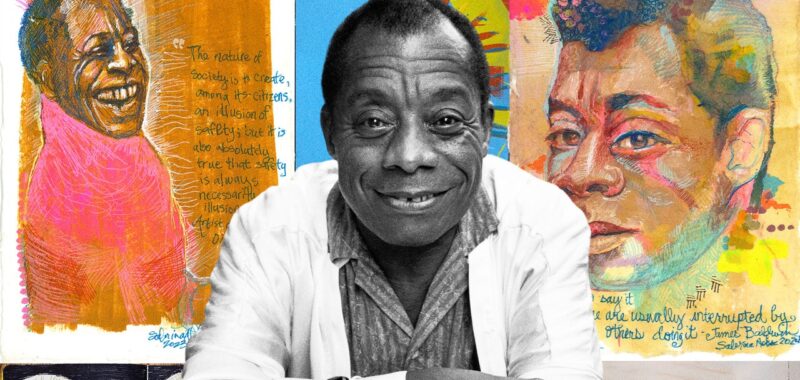When Sabrina Nelson sat down to draw James Baldwin for the first time, she felt something touch her, but no one was moving. It was 2016 and her close friend Jessica Care Moore, the poet laureate of Detroit, had invited her to create a portrait of Baldwin for a presentation at the American University of Paris. Nelson had read his works but admits she wasn’t a Baldwinite. “I just said in my heart and in my head, If you are in this room with me, you got to teach me how to know you, because I don’t know you like they know you,” she spoke of the supernatural event in that room in Paris. “And so I feel like from that moment on, he’s been with me.”
For 91 days, she drew portraits of Baldwin from memory, culminating in a traveling exhibition, co-curated with fellow Detroit artists Ashara Ekundayo and Omo Misha, titled Frontline Prophet: James Baldwin. The Wright Museum of African American History hosted a grand opening in Detroit on August 02, 2024, Baldwin’s 100th birthday. Nelson sought to create pieces that felt like Baldwin’s spirit instead of hyperrealistic paintings or drawings. Some images showcase his exuberant smile, while some linger on his melancholic gaze. Augmented reality, supplied by Black TerminusAR, allows visitors to hear his voice and read his texts. Since schools across the country continue to ban his novels, exhibits like this prevent the erasure of radical figures like Baldwin.
“When people say, Why are you obsessed with him?, I’m like, It’s not an obsession. It is me just baptizing myself in his image and all the ways that I felt like he was, through all of his layers, his depression, his happiness, his joy, his grace, his gratitude, his grief, and also his short life at 63 years, and wanting people to know who he was,” Nelson tells GQ from her office in Detroit.
Ekundayo based the exhibit’s name on a Cornel West quote. “A leader is somebody who has to jump in the middle of the fray and be prudential, we hope, rather than opportunistic,” West wrote in his 2014 book Black Prophetic Fire, “But a prophetic person tells the truth, exposes lies, bears witness and then, usually, is pushed to the margins or shot dead.” In undergrad, I was shocked to learn that Baldwin was not well-regarded among various intellectual, literary, and activist circles, not to mention the public, when he was alive. He was either too Black, too gay, too poor, or too outspoken for many in the 60s, 70s, and 80s.
His popularity has skyrocketed in recent years. During the past decade, in moments of sociopolitical upheaval, it’s become commonplace to circulate videos of Baldwin and quotes from his essays. This was especially true during the summer of 2020 when there was a global call to action against anti-blackness and police brutality. Recently, his critiques of white supremacy and Western hegemony have provided wisdom for those protesting against the genocide in Palestine.

